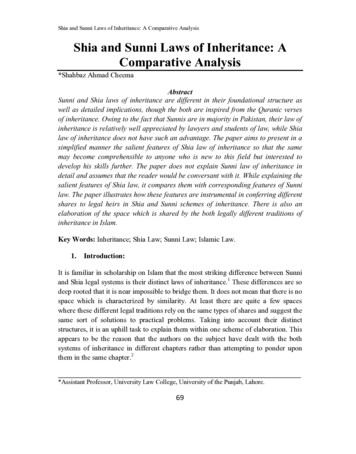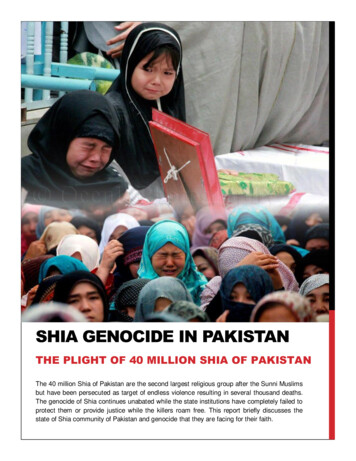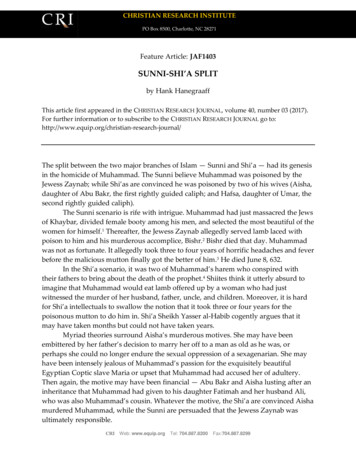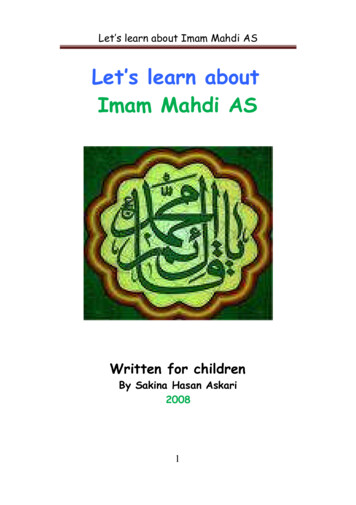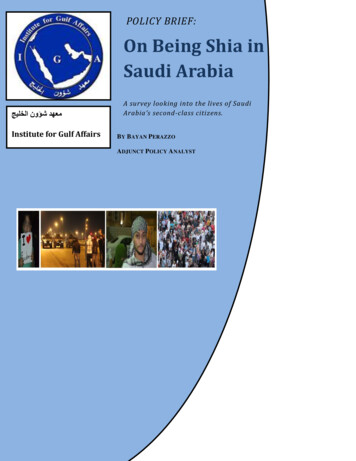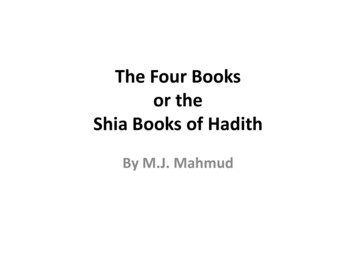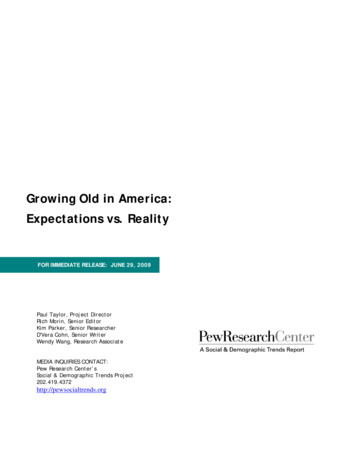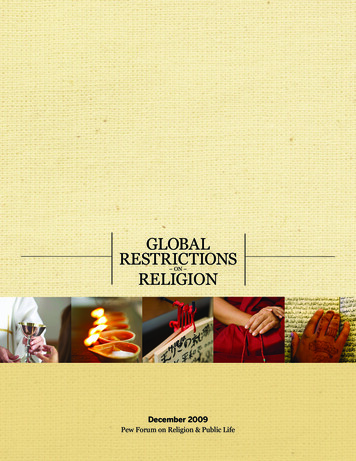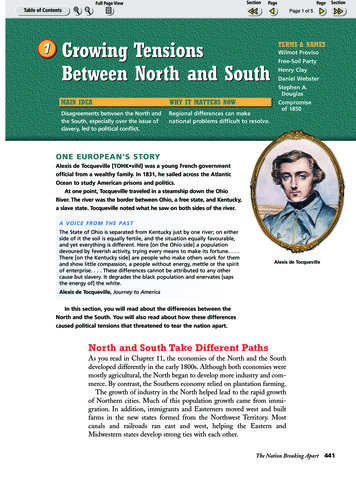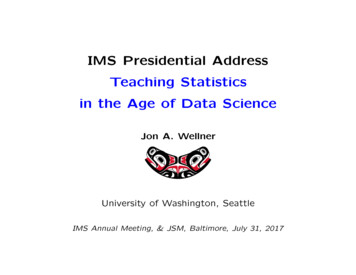
Transcription
1PEW RESEARCH CENTERThis week Sunni and Shia Muslims ushered inthe Islamic New Year and the beginning of theSunni-Shia Tensionsholy month of Muharram. For Shias, the month% of all Muslims who say Sunni-Shia tensions are a veryor moderately big problem in their countryalso is a time to mourn the events that sparkedVery bigModerately bigthe centuries-old schism between Shia andNet1Sunni Muslims. Pew Research Center pollsLebanon382967conducted in 2011-2012 find high levels ofIraq232952concern about sectarian tensions in severalAfghanistan202444countries where Sunnis and Shias live side byIran* 71623side. These concerns are particularly2Azerbaijan 1 1pronounced in Lebanon, where fully two-thirds* Question modified in Iran to ask how prevalent tensions areof all Muslims, including about half of Shiasbetween Sunnis and Shias.and 80% of Sunnis, say sectarian tensions are aPEW RESEARCH CENTER Global Survey of Muslims Q87, Q87IRN.very big or moderately big problem. Roughlyhalf of all Muslims in Iraq, more than four-inten in Afghanistan and nearly a quarter in Iran say the same.The polls were conducted from November 2011 to May 2012 among a total of more than 5,000Muslims in five countries with substantial numbers of both Shias and Sunnis (Afghanistan,Azerbaijan, Iran, Iraq and Lebanon).2 Although Shias make up only about 10%-13% of the world’sMuslims, three of the five countries surveyed (Iran, Iraq and Azerbaijan) have Shia-majoritypopulations.3 Several of the countries polled also have a recent history of sectarian violence. Thisincludes Lebanon, where a civil war was fought along sectarian lines from 1975 to 1991, and Iraq1 The divide between Sunnis and Shias dates back to a dispute over leadership succession following the death of the ProphetMuhammad in 632 C.E. For more information on the distinctions between Sunnis and Shias, see the sidebar on page 22 of the PewResearch Center’s August 2012 report “The World’s Muslims: Unity and Diversity.”2 For more survey results on Muslims in these five countries, see the Pew Research Center’s reports “The World’s Muslims: Unity andDiversity” (August 2012), “The World’s Muslims: Religion, Politics and Society” (April 2013) and “Iranians’ Views Mixed on Political Rolefor Religious Figures” (June 2013).3 For more on the share of each country’s total population that is Muslim, and the share of the Muslim population that is Shia andSunni, see the Pew Research Center’s reports “The Global Religious Landscape” (December 2012) and “Mapping the Global MuslimPopulation” (October 2009).www.pewresearch.org/religion
2PEW RESEARCH CENTERand Afghanistan, wherebombings and other suspectedsectarian attacks have occurredin the last few years.4In addition to concerns aboutsectarian tensions, concernsabout religious extremism ingeneral also are widespread inthe countries surveyed, withabout two-thirds of all Muslimsin Iraq and Afghanistan, half ofall Muslims in Lebanon androughly a quarter of allMuslims in Iran expressingworry about radical religiousgroups. However, whenmembers of the two sects arecompared, Shias tend toexpress less concern thanSunnis about extremist groups,despite the fact that Shias are aminority among Muslimsglobally and often have beentargets of religious violence.Similarly, Shias are less likelythan Sunnis to say thattensions between the two sectsare a major problem in theircountry.The polls also show thatconcerns about religiousShia and Sunni Muslims Living Side by SideCountries surveyed:Source: Data on the share of each country’s Muslim population that is Shia and Sunni fromthe Pew Research Center’s October 2009 report “Mapping the Global Muslim Population.”Data on the share of each country’s total population that is Muslim from the Pew ResearchCenter’s December 2012 report “The Global Religious Landscape.”PEW RESEARCH CENTER4 See, for example, Arango, T. Sept. 27, 2013. Rise in Deadly Attacks on Shiites in Iraq Stirs Anger at Government. New York Times,and Nordland, R. Dec. 6, 2011. Rare Attacks on Shiites Kill Scores in Afghanistan. New York Times.www.pewresearch.org/religion
3PEW RESEARCH CENTERtensions do not always go hand-in-hand with perceptions of religious freedom. In Lebanon, forexample, the vast majority of both Shias and Sunnis describe themselves as very free to practicetheir faith, even though many express concern about sectarian tensions and religious extremism.With regard to religious beliefs and practices, the polls find that majorities of Shia and SunniMuslims share key tenets of the Islamic faith, including belief in one God and the ProphetMuhammad, belief in heaven and hell, and observance of fasting during Ramadan. In addition,within individual countries, Shia and Sunni Muslims tend to exhibit similar levels of religiouscommitment. While Shias and Sunnis are united by many beliefs and practices, however, theydiffer substantially in their attitudes toward certain rituals commonly practiced by Shias duringMuharram. On the 10th day of Muharram, Shias commemorate the death of the ProphetMuhammad’s grandson, Hussein, by making pilgrimages to holy shrines. The polls show that visitsto shrines are nearly universally accepted by Shias, while Sunnis are significantly less likely to sayit is permissible in Islam to visit the shrines of saints.www.pewresearch.org/religion
4PEW RESEARCH CENTERIn four of the five countries surveyed, sizablepercentages of both Shias and Sunnis areconcerned about sectarian conflict. Two-thirdsof all Muslims in Lebanon describe sectariantensions as a very big or moderately bigproblem in their country. Roughly half ofMuslims in Iraq (52%) share this assessment, asdo more than four-in-ten in Afghanistan (44%)and nearly a quarter (23%) in Iran.Shias Less Concerned About SectarianTensions% of who say Sunni-Shia tensions are a very ormoderately big problem in their countryAll qSignificant differences shown in bold.*Question modified in Iran to ask how prevalent tensions arebetween Sunnis and Shias.However, Shias and Sunnis sometimes differ onPEW RESEARCH CENTER Global Survey of Muslims Q87, Q87IRN.how big a problem sectarian tensions pose intheir country. In Iraq, for example, Shias are 33percentage points less likely than Sunnis to say that tensions between the sects are a very big ormoderately big problem. Similarly, in both Lebanon and Iran, Shias are 27 points less likely thanSunnis to see sectarian conflict as a major problem. But Shias and Sunnis in Afghanistan do notdiffer significantly in their assessments of sectarian tensions. And in Azerbaijan, few Muslims –either Shias or Sunnis – see sectarian conflict as a major problem.Substantial percentages of Muslims in four of the five countries surveyed say they are very orsomewhat concerned about religious extremism. Half or more are worried about extremist groupsin Iraq (68%), Afghanistan (64%) and Lebanon (50%), while more than a quarter say the same inIran (28%). In Azerbaijan, by contrast, fewer than one-in-ten Muslims (6%) indicate they areconcerned about religious extremism.Within individual countries, Shia and SunniMuslims do not always share the same level ofconcern about extremist groups. The gap isparticularly wide in Lebanon, where Shias are32 percentage points less likely than Sunnis tosay they are very or somewhat concerned aboutreligious extremism. Shias also are significantlyless worried about extremist groups in Iraq (-19points) and Iran (-17). By contrast, the two sectsshare similar levels of concern in Afghanistanand Azerbaijan.Shias Less Concerned About ExtremistReligious Groups% of who say they are very or somewhat concernedabout religious extremist groupsAll 82744-17Afghanistan645964-5Azerbaijan6109 1LebanonSignificant differences shown in bold.PEW RESEARCH CENTER Global Survey of Muslims Q85.www.pewresearch.org/religion
5PEW RESEARCH CENTERIn four of the five countries where substantialnumbers of Shias and Sunnis were surveyed,most Muslims say they are very free to practicetheir faith. But only about half (48%) of allMuslims in Iraq – including 58% of Iraqi Shiasand 42% of Iraqi Sunnis – describe themselvesas very free to practice their religion.Shias More Likely to Say They are Freeto Practice Their Faith% of who say they are very free to practice their faithIranAll Muslims84Shias88Sunnis44Diff. 44Iraq485842 16Azerbaijan717459 15Afghanistan728172 9Lebanon9090900Significant differences shown in bold.Perhaps not surprisingly, in the three countriesPEW RESEARCH CENTER Global Survey of Muslims Q9.where Shias are clearly in the majority – Iran,Iraq and Azerbaijan – Shias are much morelikely than Sunnis to say they are very free to practice their faith. The biggest difference is in Iran,where Shia Muslims are twice as likely as Sunnis to feel that they are very free religiously (88% vs.44%). In Lebanon, by contrast, fully 90% of both Sunnis and Shias describe themselves as veryfree to practice their faith.www.pewresearch.org/religion
6PEW RESEARCH CENTERBelief in Key Tenets of IslamWhen it comes to religious beliefs and practices,the surveys reveal that Shias and Sunnis areunited by key tenets or articles of the Islamicfaith – beginning with the fundamental belief inGod and His Prophet Muhammad.5 In all fivecountries surveyed, Shias and Sunnis nearlyunanimously say they believe in God and theProphet Muhammad.% who believe in Belief in life after death – another core belief inIslam – is very high among both Shias andSunnis, with roughly nine-in-ten or more ineach of the countries surveyed agreeing there isa heaven and hell.6 Only in Iraq are Shiassomewhat less likely than Sunnis to believe inhell (89% vs. 98%, respectively).Belief in angels and predestination representtwo other central articles of faith in Islam. Inthe five countries surveyed, overwhelmingmajorities of Shias and Sunnis say they believein angels and predestination. There are notsignificant differences by sect in attitudestoward these core tenets of Islam in any of thefive countries surveyed.ShiasSunnisDiff.God and His Prophet Muhammad*Iraq10099 1Iran9998 0 2Lebanon98980Iraq9899-1Iran9394-1Hell*Lebanon9895 3Azerbaijan9190 1Iran9192-1Iraq8998-9AngelsAzerbaijan9587 redestination (Fate)Iran8581 4Afghanistan9695 1Lebanon89890Azerbaijan9496-2Iraq9294-2Significant differences shown in bold.*Question not asked in Afghanistan.PEW RESEARCH CENTER Global Survey of Muslims Q43a, Q43b,Q43c, Q43f and Q43j5 For more information on articles of faith in Islam, see Chapter 3 of the Pew Research Center’s August 2012 report “The World’sMuslims: Unity and Diversity.”6 The Quran states that one day God will judge each individual based on his or her deeds and reward those who have lived righteouslives while punishing those who have not. (Quran 2:81-82.)www.pewresearch.org/religion
7PEW RESEARCH CENTERImportance of Religion% of who say religion is very importantUnlike belief in key articles of the Islamicfaith, personal religious commitment widelyvaries among the publics surveyed. Thisvariation is primarily from country to country;within individual countries, Shias and Sunnistend to report similar levels of Iraq77Iran8551In Afghanistan, Iraq and Iran, for example, atLebanon66least three-quarters of Shias and Sunnis say47religion is very important to them, with noAzerbaijan43significant differences between the sects. InAzerbaijan, too, Shias and Sunnis share aPEW RESEARCH CENTER Global Survey of Muslims Q36.similar view of religion, with just under half ineach group (47% and 43%, respectively) sayingreligion is very important in their lives. Only in Lebanon do the two sects differ significantly overthe importance of religion: 66% of Lebanese Sunnis say religion is very important, compared with51% of Lebanese Shias.When it comes to fasting during the holymonth of Ramadan – a central pillar of Islam– there is, again, substantial variation betweencountries but little discernible differencebetween Shias and Sunnis within eachcountry. In Iraq, Afghanistan, Lebanon andIran, for instance, more than eight-in-tenmembers of both sects say they fast duringRamadan. In Azerbaijan, by contrast, fewerthan half of either Shias (48%) or Sunnis(42%) report that they observe the traditionalfast during daylight hours throughout themonth. In none of the countries surveyed areeither Shia or Sunni Muslims significantlymore observant of the Ramadan fast.Fast for Ramadan% of who say they fast during on8284IranAzerbaijan4842PEW RESEARCH CENTER Global Survey of Muslims Q64f.www.pewresearch.org/religion
8PEW RESEARCH CENTERWithin each country, the survey also finds, Shias and Sunnis tend to pray and attend mosque atsimilar rates. Indeed, only in Afghanistan is there a significant difference between the sects:Afghan Shias are 15 percentage points less likely than Afghan Sunnis to say they pray several timesa day (77% vs. 92%). Elsewhere, Shias and Sunnis in all the countries surveyed closely resembleone another in frequency of prayer and mosque attendance.www.pewresearch.org/religion
9PEW RESEARCH CENTERDespite sharing many core beliefs andpractices, Shias and Sunnis differ on theacceptability of certain practices oftenassociated with Muharram. The month ofMuharram is sacred to all Muslims, but forShias the 10th day of the month, Ashura, holdsspecial significance. Ashura is a time whenmany Shias commemorate the death of theProphet Muhammad’s grandson, Hussein, bymaking pilgrimages to Hussein’s tomb or thegravesites of other Muslim saints.7Visiting Shrines of Muslim Saints% who say visiting shrines of saints is ijan92Afghanistan7189The veneration of saints is one practice thatIran28often distinguishes Shias from Sunnis in thecountries polled. In Iran, for example, roughlyPEW RESEARCH CENTER Global Survey of Muslims Q42a.nine-in-ten Shias (89%) say it is acceptable inIslam to visit the shrines of Muslim saints,compared with barely three-in-ten Sunnis (28%) who say the same. Shias in Iraq and Afghanistanalso are much more likely than their Sunnicompatriots to describe pilgrimages to saints’Appealing to Deceased Forebearstombs as an accepted Muslim practice ( 33% who say appealing to the dead is acceptableand 21 percentage points, respectively).By contrast, the gap in Shia and Sunniattitudes is smaller in Azerbaijan ( 7percentage points) and nearly nonexistent inLebanon, where both Shia and Sunni Muslimsnearly universally say pilgrimages to thetombs of Muslim saints are acceptable.In all five countries, fewer than half of bothShia and Sunni Muslims say that Islampermits appealing to dead relatives orancestors for aid. However, Shias ranSunnis1620574PEW RESEARCH CENTER Global Survey of Muslims Q42d.7 For additional information regarding Ashura, see Esposito, J., ed. “Ashura” in The Oxford Dictionary of Islam. Oxford: OxfordUniversity Press, page 83.www.pewresearch.org/religion
10PEW RESEARCH CENTERsignificantly more likely than Sunnis to accept this practice. The gaps are largest in Iraq ( 36) andAfghanistan ( 34), while significant differences are also found in Azerbaijan ( 15) and Lebanon( 12). Only in Iran is there virtually no difference in Shia and Sunni attitudes toward appealing todeceased relatives or forebears.www.pewresearch.org/religion
11PEW RESEARCH CENTERResults for the survey are based on face-to-face interviews conducted under the direction ofOpinion Research Business in Iran and Iraq and Princeton Survey Research AssociatesInternational in the other three countries. Findings are reported exclusively for Muslims; however,the survey is based on national samples that did not screen out non-Muslims. In certain instances,regions of countries with high levels of insecurity or limited access were excluded from thenational samples.In all countries, surveys were administered through face-to-face interviews conducted at arespondent’s place of residence. All samples are based on area probability designs, which typicallyentailed proportional stratification by region and urbanity, selection of primary sampling units(PSUs) proportional to population size, and random selection of secondary and tertiary samplingunits within PSUs. Interview teams were assigned to designated random routes at the block orstreet level and followed predetermined skip patterns when contacting households. Withinhouseholds, adult respondents were randomly selected by enumerating all adults in the householdusing a Kish grid or selecting the adult with the most recent birthday.The questionnaire was designed by the staff of the Pew Research Center’s Religion & Public LifeProject in consultation with subject matter experts and advisers to the project. The questionnairewas translated into the vernacular language(s) of each country, checked through back-translationand pre-tested prior to fieldwork.Conducting opinion polls in diverse societies necessitates adapting the survey to local sensitivities.In some countries, pre-test results indicated the need to suppress certain questions to avoidoffending respondents and/or risking the security of the interviewers. In other countries,interviewers considered some questions too sensitive to pre-test. Thus, not all questions wereasked in all countries.Surveying in Iran presents special challenges, owing in part to U.S. government restrictions on theimport and export of goods and services to and from the country. In conducting its survey ofIranian public opinion, Pew Research fully complied with the requirements mandated by the U.S.Government’s Office of Foreign Assets Control (OFAC).For results based on the Muslim sample in the countries surveyed, one can say with 95%confidence that the error attributable to collecting data from some, rather than all, members of theMuslim population is plus or minus the margin of error. This means that in 95 out of 100 samplesof the same size and type, the results obtained would vary by no more than plus or minus thewww.pewresearch.org/religion
12PEW RESEARCH CENTERmargin of error for the country in question. Please note that margins of error for sub-populations,such as Sunni and Shia Muslims, are larger than that for the overall Muslim populations surveyed.In addition to sampling error, one should bear in mind that question wording and practicaldifficulties in conducting surveys can introduce error or bias into the findings of opinion polls. Itshould also be noted that the sample was disproportionately male in Afghanistan.AfghanistanSample size: 1,509 Muslims (1,346 Sunnis and 119 Shias)Margin of error: 4.7 pointsSample design: Stratified area probability sample of all 34 Afghan provinces (excluding nomadicpopulations) proportional to population size and urban/rural population.Mode: Face-to-face adults 18 Languages: Baloch, Dari, Hazara, Pashto, UzbekFieldwork dates: Nov. 27–Dec. 17, 2011Representative: Nationally representative of 94% of the adult population.Design effect: 3.4AzerbaijanSample size: 996 Muslims (143 Sunnis and 373 Shias)Margin of error: 5.6 pointsSample design: Stratified area probability sample of eight of 11 oblasts (excluding UpperKarabakh, Nakhchivan and Kalbacar-Lacin) and city of Baku proportional to population size andurban/rural population.Mode: Face-to-face adults 18 Languages: Azeri, RussianFieldwork dates: Dec. 4–Dec. 25, 2011Representative: Nationally representative of 85% of the adult population.Design effect: 3.3IranSample size: 1,519 Muslims (133 Sunnis and 1,384 Shias)Margin of error: 3.2 pointsSample design: Stratified area probability sample of all nine main regions proportional topopulation size and urban/rural population.Mode: Face-to-face adults 18 Languages: Farsi (Persian), Kurdish, Turkish, Gilaki, Baloch, Luri and Arabic.Fieldwork dates: Feb. 24–May 3, 2012Representative: Nationally representative of the adult population.www.pewresearch.org/religion
13PEW RESEARCH CENTERDesign effect: 1.7IraqSample size: 1,416 Muslims (596 Sunnis and 731 Shias)Margin of error: 5.8 pointsSample design: Stratified area probability sample of all 18 governorates proportional to populationsize and urban/rural population.Mode: Face-to-face adults 18 Languages: Arabic, KurdishFieldwork dates: Nov. 4–Dec. 1, 2011Representative: Nationally representative of the adult population.Design effect: 4.9LebanonSample size: 551 Muslims (279 Sunnis and 272 Shias)Margin of error: 6.1 pointsSample design: Stratified area probability sample of all seven regions (excluding areas ofBeirut controlled by a militia group and a few villages in the south near the border with Israel)proportional to population size and urban/rural population.Mode: Face-to-face adults 18 Languages: ArabicFieldwork dates: Nov. 14–Dec. 8, 2011Representative: Nationally representative of 98% of the adult population.Design effect: 2.2www.pewresearch.org/religion
Sunni-Shia Tensions % of all Muslims who say Sunni-Shia tensions are a very or moderately big problem in their country * Question modified in Iran to ask how prevalent tensions are between Sunnis and Shias. PEW RESEARCH CENTER Global Survey of Muslims Q87, Q87IRN. 38 23 20 7 1 29 29Iraq 24Afghanistan 16Iran* 1 Lebanon Azerbaijan Very big .
